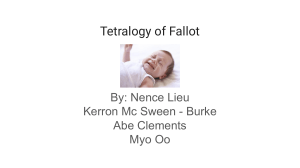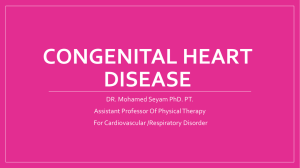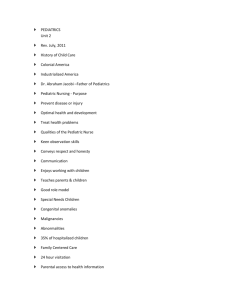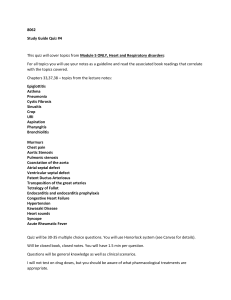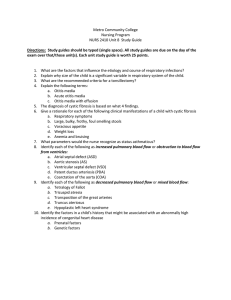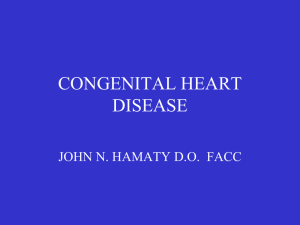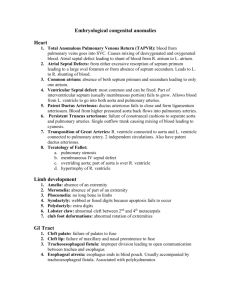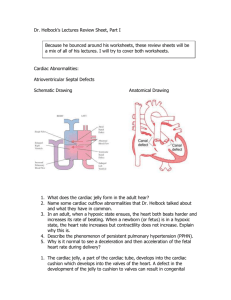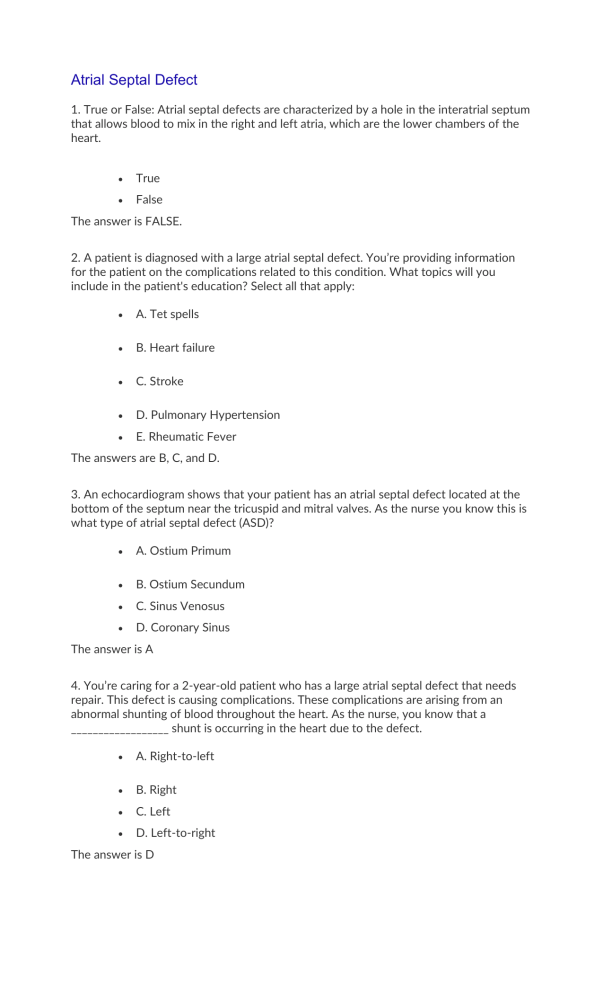
Atrial Septal Defect 1. True or False: Atrial septal defects are characterized by a hole in the interatrial septum that allows blood to mix in the right and left atria, which are the lower chambers of the heart. • True • False The answer is FALSE. 2. A patient is diagnosed with a large atrial septal defect. You’re providing information for the patient on the complications related to this condition. What topics will you include in the patient's education? Select all that apply: • A. Tet spells • B. Heart failure • C. Stroke • D. Pulmonary Hypertension • E. Rheumatic Fever The answers are B, C, and D. 3. An echocardiogram shows that your patient has an atrial septal defect located at the bottom of the septum near the tricuspid and mitral valves. As the nurse you know this is what type of atrial septal defect (ASD)? • A. Ostium Primum • B. Ostium Secundum • C. Sinus Venosus • D. Coronary Sinus The answer is A 4. You’re caring for a 2-year-old patient who has a large atrial septal defect that needs repair. This defect is causing complications. These complications are arising from an abnormal shunting of blood throughout the heart. As the nurse, you know that a __________________ shunt is occurring in the heart due to the defect. • A. Right-to-left • B. Right • C. Left • D. Left-to-right The answer is D 5. You’re assessing the heart sounds of a child with an atrial septal defect. You note a heart murmur at the 2nd intercostal space at the left upper sternal border. Heart murmurs noted in patients with an atrial septal defect are called? • A. Holosystolic murmurs • B. Diastolic murmurs • C. Early systolic murmurs • D. Midsystolic murmurs The answer is D 6. Select the structure below that allows blood to flow from the right to left atrium in utero and that should close after birth: • A. Ductus Arteriosus • B. Formen Ovale • C. Ductus Venosus • D. Ligamentum teres The answer is B 7. After admitting a child with an atrial septal defect, you start developing a nursing care plan. What nursing diagnoses can you include in the patient's plan of care based on the complications that arise from this condition? Select all that apply: • A. Activity Intolerance • B. Risk for Infection • C. Decrease Cardiac Output • D. Excess Fluid Volume • E. Risk for Aspiration The answers are A, B, C, and D. 8. True or False: Atrial septal defects can lead to a decrease in lung blood flow. • True • False The answer is FALSE Ventricular Septal Defect 1. A two-month-old is showing signs and symptoms of heart failure. An echocardiogram is ordered. The test shows the infant has a ventricular septal defect (VSD). Which statement below best describes the blood flow in the heart due to this congenital heart defect? • A. “The blood in the heart is shunting from the right ventricle to the left ventricle, which is increasing pulmonary blood flow.” • B. “The blood in the heart is shunting from the left ventricle to the right ventricle, which is decreasing pulmonary blood flow.” • C. “The blood in the heart is shunting from the left ventricle to the right ventricle, which is increasing pulmonary blood flow.” • D. “The blood in the heart is bypassing the left ventricle and is being shunted to the right ventricle, which is decreasing lung blood flow.” The answer is C. 2. An infant has a large ventricular septal defect (VSD). The defect is located in the upper section of the ventricular septum and is near the tricuspid and aortic valve. Based on this description, what type of ventricular septal defect is this? • A. Outlet (conal or subarterial) • B. Muscular • C. Inlet (atrioventricular) • D. Membranous The answer is D. 3. TRUE or FALSE: A small muscular ventricular septal defect has a high probability of self-closure, and these types of VSDs are found in the lower portion of the ventricular septum. • True • False The answer is TRUE. 4. TRUE or FALSE: The signs and symptoms of a ventricular septal defect are most commonly detected in a baby following birth. • True • False The answer is FALSE 5. A concerned mother brings her 3-month-old to the clinic. The mother states the infant seems to be small for its age. In addition, she states the infant fatigues very easily while feeding and rarely finishes a feeding. While collecting a thorough health history, what other signs and symptoms described by the mother may indicate the child has a congenital heart defect, such as a ventricular septal defect? Select all that apply: • A. Diarrhea • B. Frequent treatment for lung infections • C. Excessive wet diapers • D. Diaphoresis when nursing • E. Swelling in the hands and feet The answers are: B, D, and E 6. After speaking with the mother of the infant in the previous question, who may have a ventricular septal defect, you auscultate heart sounds. If a ventricular septal defect was present, you may hear a harsh murmur that is _______________________. • A. Located at the lower left sternal border and starts at S1 and extends into S2. • B. Located at the upper left sternal border and is continuous during systole. • C. Located at the lower left sternal border and is continuous machine-like. • D. Located at the upper left sternal border and is only heard during diastole. The answer is A. 7. A 4-month-old is scheduled to take Digoxin for treatment of a ventricular septal defect. The patient’s apical pulse is 89 beats per minute. As the nurse you will? Select all that apply: • A. Hold the dose • B. Recheck the pulse via the brachial artery • C. Administer the dose as scheduled • D. Notify the physician The answer is A and D. 8. As the nurse you know that if a patient has a large ventricular septal defect and does not receive treatment, the patient may develop Eisenmenger Syndrome. This syndrome causes? • A. A reversal of blood shunting in the heart from right to left and will cause pulmonary hypertension. • B. A reversal of blood shunting in the heart from left to right and will cause cyanosis. • C. A reversal of blood shunting in the heart from left to right and will cause pulmonary hypertension. • D. A reversal of blood shunting in the heart from right to left and will cause cyanosis. The answer is D. Patent Ductus Arteriosus 1. You're caring for a 2-day-old infant with a large patent ductus arteriosus. The mother of the infant is anxious and asks you to explain her child's condition to her again. Which statement below BEST describes this condition? • A. "The vessel connecting the aorta and pulmonary vein has closed prematurely, which is leading to increased blood flow to the lungs." • B. "The vessel connecting the aorta and pulmonary artery has failed to close at birth, which is leading to a left-to-right shunt of blood." • C. The vessel connecting the aorta and pulmonary vein has failed to close at birth, which is leading to a right-to-left shunt of blood." • D. "The vessel connecting the aorta and pulmonary artery has closed prematurely, which is leading to a left-to-right shunt of blood." The answer is B. 2. As the nurse you know which statements below are correct about the ductus arteriosus? Select all that apply: • A. "The ductus arteriosus is a structure that should be present in all babies in utero." • B. "The ductus arteriosus normally closes about 3 days after birth or sooner." • C. "The purpose of the ductus arteriosus is to help carry blood that is entering the left side of the heart to the rest of the body, hence bypassing the lungs." • D. "The ductus arteriosus connects the aorta to the pulmonary vein." The answers are A and B 3. While assessing a newborn’s heart sounds you note a loud murmur at the left upper sternal border. You report this to the physician who suspects the infant may have patent ductus arteriosus. The physician asks you to obtain a pulse pressure. If patent ductus arteriosus is present, the pulse pressure would be ___________. • A. Narrow • B. Fluctuating • C. Wide • D. Normal The answer is C. 4. As noted in the previous question, a loud murmur was noted during assessment of a newborn with patent ductus arteriosus. As the nurse you know that what type of murmur is a hallmark sign of this condition? • A. harsh, loud systolic murmur • B. soft, blowing diastolic murmur • C. systolic and diastolic machinery-like murmur • D. machinery-like murmur present on only diastole The answer is C. 5. You’re working on a unit that provides specialized cardiac care to the pediatric population. Which patient below would be the best candidate for Indomethacin from the treatment of patent ductus arteriosus? • A. A 25-year-old adult • B. A premature infant • C. An 8 month old child • D. A 12 year old child The answer is B 6. You’re working in the NICU providing care to a neonate who has a large patent ductus arteriosus. Which finding during your head-to-toe assessment would require you to immediately notify the physician? • A. Loud, harsh continuous murmur • B. Abnormal pulse pressure • C. Crackles • D. Diaphoresis when feeding The answer is C. 7. You’re providing education to the parents of a child who has a patent ductus arteriosus. The parents want to know the complications of this condition. In your education, you will include which of the following complications of PDA? Select all that apply: • A. Heart failure • B. Pulmonary hypertension • C. Recurrent lung infections • D. Clubbing of the fingernails • E. Endocarditis • F. Pulmonary stenosis The answers are A, B, C, and E Coarctation of the Aorta 1. Select all the true statements about the aorta: • A. “The ascending aorta branches off to supply the coronary arteries of the heart.” • B. “It’s the third largest artery in the body.” • C. “The aorta comes off the right ventricle and supplies oxygenated blood to the body.” • D. “The aortic arch branches off to supply the head, neck, and upper extremities.” The answers are A and D. 2. You’re caring for a child with coarctation of the aorta and educating the parents about the child’s condition. Which statement by the parents demonstrates they understood the pathophysiology of this defect? • A. “This condition can lead to right-sided heart failure.” • B. “The narrowing of the aorta leads to a high blood pressure in the arteries that are found before the site of narrowing in the aorta.” • C. “The dilation of the aorta leads to a decrease blood pressure in the arteries that are found after the site of dilation.” • D. “The upper and lower extremities will experience a decrease in blood flow due to the defect in the aorta.” The answer is B. 3. A newborn has severe coarctation of the aorta. What signs and symptoms would you expect to find in this patient? Select all that apply: • A. Very strong bounding pulses in the upper extremities • B. Cool legs and feet • C. Machine-like murmur only on systole • D. Tet spells with activity • E. Severe cyanosis • F. Absent/diminished femoral pulses The answers are: A, B, and F. 4. You’re performing a head-to-toe- assessment on a newborn with severe coarctation of the aorta. You note a systolic heart murmur. Where is this heart murmur best auscultated in a patient with this condition? • A. at the 4th intercostal space left to the sternal border • B. at the left interscapular area • C. at the 2nd intercostal space right to the sternal border • D. at the mid-subclavicular line right of the sternal border The answer is B. 5. You’re providing discharge education to the parents of a child who just had surgery to repair coarctation of the aorta. What should the nurse include in the teaching about issues that can arise after surgery that must be closely monitored by a cardiologist? Select all that apply: • A. Dilation of the aorta • B. Restenosis of the aorta • C. Hyperglycemia • D. Hypertension The answers are B and D. After repair of the aorta, there is always the chance the aorta can narrow again (restenosis) and that the child continues to have hypertension that must be treated with medication. The cardiologist will need to monitor the patient for this long-term. 6. As the nurse you know that some patients who have coarctation of the aorta will develop collateral circulation of the arteries due to the abnormality on the aorta. Which option below indicates a patient is experiencing collateral circulation? • A. Chest x-ray that demonstrates notching on the ribs • B. A harsh diastolic murmur on inspiration at the 2nd intercostal border • C. Ejection fraction of 12% on an echocardiogram • D. Chest x-ray that demonstrates cardiomegaly The answer is A. 7. After the birth of a newborn with severe coarctation of the aorta, the physician orders a prostaglandin infusion. As the nurse you know that this medication will have what type of therapeutic effects? Select all that apply: • A. Prevent the foramen ovale from closing • B. Allow a connection between the aorta and pulmonary artery • C. Decrease the workload on the left ventricle • D. Increase blood flow to the lower extremities The answers are B, C, and D. Tetralogy of Fallot 1. You're providing an in-service to a group of new nurses who will be caring for patients who have Tetralogy of Fallot. Which statement below is INCORRECT concerning how the blood normally flows through the heart? • A. Unoxygenated blood enters through the superior and inferior vena cava and travels to the left atrium. • B. The pulmonic valve receives blood from the right ventricle and allows blood to flow to the lungs via the pulmonary artery. • C. The left atrium allows blood to flow down through the bicuspid valve (mitral) into the left ventricle. • D. Oxygenated blood leaves the left ventricle and flows up through the aortic valve and aorta to be pumped to the rest of the body. The answer is A. This statement is INCORRECT. It should say: "Unoxygenated blood enters through the superior and inferior vena cava to the RIGHT (not left) atrium. 2. A 4-month-old is diagnosed with Tetralogy of Fallot. You're providing an illustration to the parent to help him understand the pathophysiology of this condition. What defects must be present in the illustration to help the parent understand their child's condition? Select all that apply: • A. Aortic stenosis • B. Ventricular septal defect • C. Coarctation of aorta • D. Right ventricular hypertrophy • E. Displacement of the aorta • F. Pulmonic stenosis • G. Patent ductus arteriosus The answers are: B, D, E, and F. Let the condition's name help you: "TETRAOLOGY"...this means there will be FOUR problems with this heart defect. Remember from the lecture the mnemonic RAPS: Right ventricular hypertrophy, Aorta displacement, Pulmonary stenosis, Septal defect (ventricular) 3. As the nurse you know which statements are TRUE about Tetralogy of Fallot? Select all that apply: • A. "Tetralogy of Fallot is a cyanotic heart defect." • B. "In this condition the heart has to work harder to pump blood to the lungs, which cause the right ventricle to work harder and enlarge." • C. "Tetralogy of Fallot is treated with only palliative surgery." • D. "Many patients with this condition will experience clubbing of the nails." The answers are A, B, and D. Option C is wrong because this condition can be treated with both palliative surgery (used to help alleviate symptoms until the child is old enough for complete repair) and complete repair. All the other options are correct. 4. While feeding a 3-month-old infant, who has Tetralogy of Fallot, you notice the infant's skin begins to have a bluish tint and the breathing rate has increased. Your immediate nursing action is to? • A. Continue feeding the infant and place the infant on oxygen. • B. Stop feeding the infant and provide suction. • C. Stop feeding the infant and place the infant in the knee-to-chest position and administer oxygen. • D. Assess the infant’s heart rate and rhythm. The answer is C. The patient is experiencing a "tet spell". This is where during any type of activity like feeding, crying, playing etc. the child's heart (due to Tetralogy of Fallot) is unable to maintain proper oxygen levels in the blood (these activities place extra work on the heart and it can’t keep up). Therefore, there are low amounts of oxygen in the blood, and the skin will become cyanotic (bluish tint) and the respiratory rate will increase (this is the body's way of trying to increase the oxygen levels in the body but it doesn’t work because it’s not a gas exchange problem in the lungs but a heart problem). The nurse would want to place the infant in the knee-to-chest position. WHY? This increases systemic vascular resistance (which will help decrease the right to left shunt that is occurring in the heart...hence helps replenish the body with oxygenated blood). In addition, the nurse would want to place the patient on oxygen. 5. You are assessing the heart sounds of a patient with a severe case of Tetralogy of Fallot. You would expect to hear a __________ murmur at the _______ of the sternal border? • A. diastolic; right • B. systolic; left • C. diastolic; left • D. systolic; right The answer is B. The patient will have a harsh systolic murmur due to pulmonary stenosis, which would lead you to find the murmur at the LEFT of the sternal border (the sound location of the pulmonary valve). 6. As the registered nurse you are developing a plan of care for a patient with Tetralogy of Fallot. Select all the appropriate nursing diagnoses below that would be specific to this patient: • A. Risk for deficient fluid volume • B. Ineffective airway clearance • C. Activity Intolerance • D. Failure to thrive • E. Risk for impaired liver function The answers are C and D. A patient with TOF will have activity intolerance because remember this is a cyanotic heart defect where there is not enough oxygen in the blood (due to the structural defect of the heart) and any activity (feeding, crying, play etc.) can increase the demands for oxygen. Therefore, the patient will experience activity intolerance. In addition, the patient can experience failure to thrive because the constant hypoxemia (low oxygen in the blood) experienced can lead the child to have poor growth, weight loss, clubbing of the nails etc. Remember organs need plenty of oxygen to work and grow but in TOF this isn't happening very well. Options A, B, and E are not appropriate nursing diagnoses. 7. A family member, who is caring for a 2-year-old with Tetralogy of Fallot, asks you why the child will periodically squat when playing with other children. Your response is: • A. “Squatting helps to increase systemic vascular resistance, which will decrease the right to left shunt that is occurring in the ventricles and this helps increase oxygen levels.” • B. “Squatting helps to decrease systemic vascular resistance, which will decrease the left to right shunt that is occurring in the ventricles and this helps increase oxygen levels.” • C. “Squatting helps to decrease systemic vascular resistance, which will increase the right to left shunt that is occurring in the ventricles and this helps increase oxygen levels.” • D. “Squatting helps to normalize systemic vascular resistance, which will increase the left to right shunt that is occurring in the ventricles and this helps increase oxygen levels.” The answer is A. Squatting is common in patient with TOF. Why? Squatting helps to increase systemic vascular resistance, which will decrease the right to left shunt that is occurring in the ventricles and this helps increase oxygen levels. 8. You're caring for a newborn who has Tetralogy of Fallot with severe cyanosis. You anticipate the newborn will be started on ___________? • A: Indomethacin • B. Diclofenac • C. Celecoxib • D. Alprostadil The answer is D Truncus Arteriosus 1. A newborn is diagnosed with truncus arteriosus. You're educating the parents about this heart defect. Which statement by the mother demonstrates she understood the education provided about this condition? • A. "My baby has narrowing in the pulmonary artery, and the aorta is arising out of the right ventricle rather than the left ventricle." • B. "My baby's heart shares one artery that connects the right and left ventricles." • C. "The left side of my baby's heart is not fully developed." • D. "The natural structure in my baby's heart, the ductus arteriosus, has failed to close after birth leading to more blood flow to the lungs." The answer is B. Truncus arteriosus is a congenital heart defect where there is ONE artery along with one truncal valve that connects the right and left ventricles. This structure will function to carry blood to both the lungs and body. In a normal heart, there should be TWO separate arteries (pulmonary artery and aorta) with their own valves (instead of one truncal valve). The pulmonary artery will carry blood from the right side of the heart to the lungs, and the aorta will carry blood from the left side of the heart to the body. 2. What other congenital heart defect is most commonly present in truncus arteriosus? • A. Atrial septal defect • B. Pulmonary stenosis • C. Tetralogy of Fallot • D. Ventricular septal defect The answer is D. A ventricular septal defect (VSD) is commonly present in this CHD. The VSD will be near the truncus arteriosus and it will allow blood to mix in the right and left ventricles and enter the truncus artery. It is very uncommon for one not to be present. 3. Which of the following genetic disorders increases a patient risk of developing truncus arteriosus? • A. Edward's syndrome (trisomy 18) • B. Down syndrome • C. DiGeorge syndrome • D. Patau syndrome The answer is C. About 33% of babies with truncus arteriosus have a genetic problem called DiGeorge syndrome (C.S. Mott Children's Hospital). 4. A 3-day-old infant is diagnosed with truncus arteriosus. As the nurse, you know to monitor the infant for what complications? Select all that apply: • A. Tet spells • B. Heart failure • C. Pulmonary hypertension • D. Increased cardiac output The answers are B and C. This infant has only one artery that is arising out of the right and left ventricle. Deoxygenated and oxygenated blood is mixing in the ventricles, entering the truncus arteriosus, and going to both the lungs and systemic circulation. Consequently, more blood is flowing to the lungs than the systemic circulation (the body) because resistance in lower to the lungs than the body. Hence, it is easier to pump blood to the lungs than to body (blood flow to the body requires a lot of pressure when compared to the lungs). It’s important to note that the blood that is entering the body is a mixture of deoxygenated and oxygenated blood (leading to cyanosis). Now because there is more blood flow going to the lungs, this leads to damage to the arteries that feed the lungs, and this leads to pulmonary hypertension. The pulmonary hypertension increases the resistance the heart must pump against to get the blood to the lungs. Therefore, the heart becomes very weak from having to pump so hard against the resistance to the lungs, and this leads to heart failure. Many infants with a severe case of truncus arteriosus will develop heart failure within the first 7 days of life. Tet spells are found in the congenital heart defect tetralogy of fallot, and there is DECREASED cardiac output with this condition (not increased). 5. A 1-day-old infant is ordered an echocardiogram due to abnormal signs and symptoms related to a congenital heart defect. The echo confirms that truncus arteriosus is present. What signs and symptoms may present in this congenital heart defect? Select all that apply: • A. Cyanosis • B. Machinery-like murmur • C. Poor feeding • D. Inability to gain weight • E. Hypercyanotic spells • F. Clubbing of fingers The answers are A, C, and D. Deoxygenated blood is going to the body, while more blood is shifting to pulmonary circulation via a shared artery. This leads to cyanosis (bluish body at birth) and dyspnea. Heart failure and pulmonary hypertension occur within the first weeks of life. The baby can experience poor feeding and poor weight gain, low cardiac output, activity intolerance, sweating that is cold and calmly, nutrition issues, crackles in lungs etc. A heart murmur from the blood flowing through the truncus arteriosus can create a turbulence leading to an ejection systolic murmur heard at the left sternal border. A machinery-like murmur is present in patent ductus arteriosus, and hypercyanotic spells are present in tetralogy of fallot (also called tet spells). 6. You're teaching a class to a group of parents about congenital heart defects. During the class discussion, you ask the group to describe the surgical repair for truncus arteriosus. Select all the TRUE statements by the group members about this surgical repair: • A. "During the surgery the pulmonary arteries are separated from the truncus arteriosus and connected to the right ventricle using a valved conduit." • B. "This surgery is done within the first 2-3 months of life." • C. "Some patients may need another surgical repair later on because of narrowing of the conduit that may occur or they may outgrow it." • D. "During the surgery the aorta is separated from the truncus arteriosus and connected to the left ventricle using a valved conduit." The answers are A and C. These are the only correct statements. Option B is WRONG because this surgery is performed with the first 2 weeks of life. Option D is wrong because during the surgery the pulmonary arteries are separated from the truncus arteriosus and connected to the right ventricle using a valved conduit. 7. A newborn is taking Digoxin prior to surgical repair of a truncus arteriosus. You’re assessing morning labs and the patient’s Digoxin level is 1.8 ng/mL. The next dose of Digoxin is due at 1000. As the nurse you will? Select all that apply: • A. Redraw a Digoxin level to confirm the morning lab level • B. Hold the 1000 dose and notify the physician • C. Administer the dose as ordered • D. Administer the dose as ordered, but notify the physician about the abnormal level • E. Check apical pulse prior to administration of the scheduled dose at 1000 • F. Hold scheduled dose if apical pulse less than 60 The answers are: C and E. A normal digoxin level is 0.5-2 ng/mL (the patient’s digoxin level is normal in this scenario). Therefore, the nurse should ADMINISTER the dose as ordered…..AFTER checking the apical pulse. The nurse would hold the dose if the apical pulse was less than 90-110 beats per minute in an INFANT. It is less than 60 bpm for adults (that is why option F is wrong). 8. An ACE inhibitor is ordered by the physician for an infant with truncus arteriosus. This medication will decrease afterload and help with the management of heart failure. Which medication below is an ACE inhibitor? • A. Losartan • B. Celiprolol • C. Furosemide • D. Catopril The answer is D. This is an ACE inhibitor. 9. You’re developing a care plan for an infant with truncus arteriosus. When analyzing the pathophysiology for this condition, what nursing diagnosis can be included in this patient’s plan of care? Select all that apply: • A. Risk for increase cardiac output • B. Imbalance Nutrition • C. Activity intolerance • D. Ineffective breathing pattern The answers are B, C, and D. This patient with truncus arteriosus may experience heart failure and pulmonary hypertension along with cyanosis. Heart failure will lead to fatigue, which leads to an inability to tolerant activity (this includes feeding). The infant is at risk for poor feeding and may not be able to gain weight. In addition, breathing will be affected because a dyspnea experienced due to heart failure and cyanosis (patient is unable to get oxygenated blood to the body) leading to an ineffective breathing pattern. 10. Prior to surgery for truncus arteriosus, what medications may be ordered to help with heart function and complications related to heart failure? Select all that apply: • A. Angiotensin II receptor blockers (ARBs) • B. Digoxin • C. ACE Inhibitors • D. Diuretics The answers are B, C, and D
